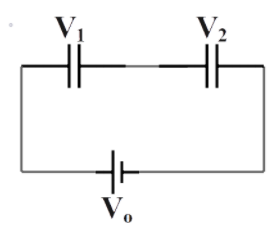
Two identical parallel plate capacitors are placed in series and connected to a constant voltage source
A.
B.
C.
D.
Answer
492.9k+ views
Hint: In this question we are asked to calculate the potential difference of a capacitor. It is given that other capacitor connected in series is later filled with dielectric with dielectric constant K. To solve this, we will assume the potential difference in the capacitor plates and later again calculate the potential difference when the dielectric is filed. We know that the charge in the circuit is conserved. Therefore, we will be using this to calculate our final answer.
Formula Used: -
Where,
V is the potential difference
Where,
C is the capacitance
Complete answer:
We know that potential difference in over circuit when the capacitors are connected in series is given by,

Now, we also know that the charge in both the capacitors will be equal and conserved. It can be given by,
Now, assume that the capacitor 1 is filled with dielectric with dielectric constant K. We know the capacitance in both the capacitors is equal as they are said to be identical. Therefore, above equation will become,
Therefore,
After substituting the above value in equation (1)
We get,
Therefore,
On solving,
We get,
Therefore, the correct answer is option B.
Note:
A capacitor is a device used to store the electric energy in an electric field. A capacitor works on the principle that the capacitance of the conductor increases when an earthed conductor is brought near it. We know that the positive and negative charges attract each other. The plates of the capacitor contain the opposite charged particles. This creates an electric field in between the plates. This is how a capacitor stores energy.
Formula Used: -
Where,
V is the potential difference
Where,
C is the capacitance
Complete answer:
We know that potential difference in over circuit when the capacitors are connected in series is given by,

Now, we also know that the charge in both the capacitors will be equal and conserved. It can be given by,
Now, assume that the capacitor 1 is filled with dielectric with dielectric constant K. We know the capacitance in both the capacitors is equal as they are said to be identical. Therefore, above equation will become,
Therefore,
After substituting the above value in equation (1)
We get,
Therefore,
On solving,
We get,
Therefore, the correct answer is option B.
Note:
A capacitor is a device used to store the electric energy in an electric field. A capacitor works on the principle that the capacitance of the conductor increases when an earthed conductor is brought near it. We know that the positive and negative charges attract each other. The plates of the capacitor contain the opposite charged particles. This creates an electric field in between the plates. This is how a capacitor stores energy.
Recently Updated Pages
Master Class 9 General Knowledge: Engaging Questions & Answers for Success

Master Class 9 English: Engaging Questions & Answers for Success

Master Class 9 Science: Engaging Questions & Answers for Success

Master Class 9 Social Science: Engaging Questions & Answers for Success

Master Class 9 Maths: Engaging Questions & Answers for Success

Class 9 Question and Answer - Your Ultimate Solutions Guide

Trending doubts
Give 10 examples of unisexual and bisexual flowers

What is the Full Form of PVC, PET, HDPE, LDPE, PP and PS ?

Two reactions A to products and B to products have class 12 chemistry CBSE

What are the advantages of parallel combination over class 12 physics CBSE

Write two 2 slogans on Female foeticidea social ev class 12 biology CBSE

Using a punnett square workout the distribution of class 12 biology CBSE




